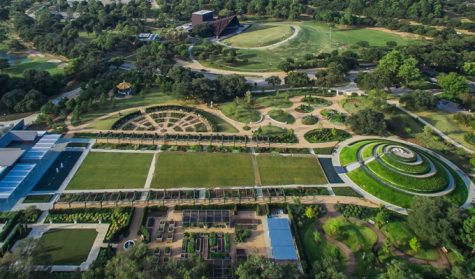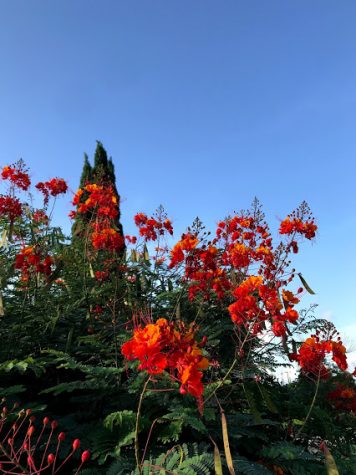A secret along the city’s streets: exploring the McGovern Centennial Gardens
The entire kindergarten class was enchanted by the Secret Garden. Every time we neared the end of music class, we would plead with Ms.Fox to tell us the story once again. Her eyes grew wide and her voice mysterious as she pantomimed her unintentional stumble into this parallel universe of exquisite nature that she called the Secret Garden. It didn’t matter that we’d heard the tale time and time again. Each word of the way transported me to a world where I could speak to dragonflies and lived in a red and white polka-dot mushroom.
Ms.Fox moved away the following year, and the secret garden became a dry plain in the drought of my memory. It remained that way for ten years, until I stepped into the McGovern Centennial Gardens. It took a tenth of a second for that secret garden to come back to life.
The Hermann Park Conservancy first broke ground on the McGovern Centennial Gardens in October 2013, as part of their Centennial celebration: 100 years of Hermann Park. In a grand culmination of the festivities, an international design team drafted a multi-garden layout to be interspersed with public art donated from countries around the world. Its ribbon was cut approximately one year later, and it now sits nestled in the museum district. Neighboring the Museum of Fine Arts Houston and the Museum of Natural Science, the Washington Post’s City Guide called it “Houston’s best kept secret.” It truly is my garden.

Giving into the urge to take the scenic route, I parked along Miller Outdoor Theatre’s backlot and made a brief trek around their boasted hill. Upon crossing Hermann Park Drive, I almost missed the Centennial, shrouded by the skyline’s typical occupants of live oaks and parking garages. After I went in, I couldn’t imagine how I nearly made the oversight. A sculpture-lined gravel path forked at the base of a 30-foot mound that cascaded upwards toward the sky, in a spiral that nudged it, rather than pierced it. I felt as if I had entered a utopia, where sculptures of Gandhi and Confucius alongside fellow philosophers and poets, were molded mid-stride, so that I walked with them, rather than away from them. At one point, a past visitor who particularly felt humored towards the greater good was kind enough to scale the sculptures and hook masks behind the historical figures’ ears, in an act that projected both the gravity of our weighing circumstances and an uplifting sigh of comic relief.
I was at a total loss for where to head first. The day was sun-soaked and the garden, gilded in gold. I simply stood along the path with dumb legs, unable to motion where to go. It wasn’t long before the wind changed its course, because even mother nature knew that I wasn’t going to move for myself anytime soon. It waltzed around my knees and up to my chin, carrying the scent of topsoil soaked in old rain up to my nose. It was a breeze that unmistakably announced that I stood in the lungs of the city, which inhaled the buildings through the fractures in the concrete, and exhaled the depths of the Earth in a reverent exchange. It was a function of the universe that seemed like I wasn’t supposed to witness, and for an instant, I was weightless. Then I headed towards the mound.
The mound itself resembles a mix between a terraced hill and a friendly volcano. It’s traced by a cemented path embellished on either side by a scaffolding of grasses and bush, and near its peak spurts a constant gush of freshwater that tramples down its side, like a stampede of high schoolers on the way to their next class. The path is meant to spiral hikers into a garden overlook at the top, but a quiet chain draws across the beginning of the incline’s entrance, yet another reality check.

As I made my way around the base of the mound, flowers played tug of war for my attention. Bright yellow buttercups and blazing orange snapdragons pulled at my peripheral vision while I attempted to admire a cluster of purple pansies, and then vice-versa. Beyond the mound and towards the inlet walkways of the Centennial’s extended gardens, a bend of rose archways cartwheeled against the sky in a funneled path, and it was the roses that particularly fascinated me. The wear of Winter had already begun to wipe the pink from their buds, leaving a shade that dabbled between a well-chewed stick of bubblegum and a shy iridescence. The petals sprawled in a pant, and the thick green shoots of the tubular plants broke their rigid tension as the forgiving afternoon satisfied their long-awaited craving for consistency. They were undoubtedly beaten down by the broken pendulum that is Houston’s weather, which starkly oscillates from blithering heat to bone-chilling. Yet somehow, I managed to visit the garden during the split in-between. I couldn’t help recalling the excitement of my kindergarten self as I surveyed the long lost secret garden before me.
Your donation will support the student journalists of Carnegie Vanguard High School. Your contribution will allow us to cover our annual website hosting costs and fund field trips, competition fees, and equipment. We appreciate your support!

Hi! I'm a junior, and I'm really passionate about listening to people's stories.







Emma Pierce • Jan 27, 2021 at 10:44 am
You set up a great story in the beginning, it is very captivating and imaginative. I like the way you connected a childhood book/ memory to a new found place. Your diction is also really impressive. And you original photos!
Nadia Talanker • Dec 23, 2020 at 2:09 pm
I’m really happy you included photos and they look great 😀 I love the way you described everything as well, overall a really good article 😀
Thomas Dowe • Dec 17, 2020 at 11:40 pm
The use of language gives a clear picture of what the story is about
MyTran Vo • Dec 17, 2020 at 11:22 am
Your metaphors and description made me feel as if i was really there in person.
Jonathon Morales • Dec 17, 2020 at 10:58 am
Great choice of words for your descriptions, seems great
Carys Reyes • Dec 17, 2020 at 10:58 am
The language used in this article is very descriptive and really takes me back to when I was in elementary school.
Andres Pargas • Dec 17, 2020 at 10:47 am
Love how you describe the place, you make it sound magical.
Ash Brown • Dec 17, 2020 at 10:45 am
Your descriptive wording and use of metaphor is extremely impressive, and really brought me into your recollection of you Kindergarten years. I really liked your recounting of the sculptures, and how you “walked with them.” This story was incredibly well written, I definitely want to visit this Secret Garden.
Vivian Huynh • Dec 17, 2020 at 10:43 am
I love your descriptions and word choice throughout the paragraph. Your figurative language really added spice to your article. It really gave me the sense that I was actually there.
Kallisti Clemons • Dec 17, 2020 at 10:41 am
The anecdote at the start about “The Secret Garden” really pulls me in and helps me visualize the gardens, before you even begin to describe them. It draws me in and makes me want to keep reading.
Lexy Silva • Dec 17, 2020 at 10:31 am
Love how when you are describing the garden, the diction you use is resemblant of the secret garden making the connection from your nostalgia to the garden